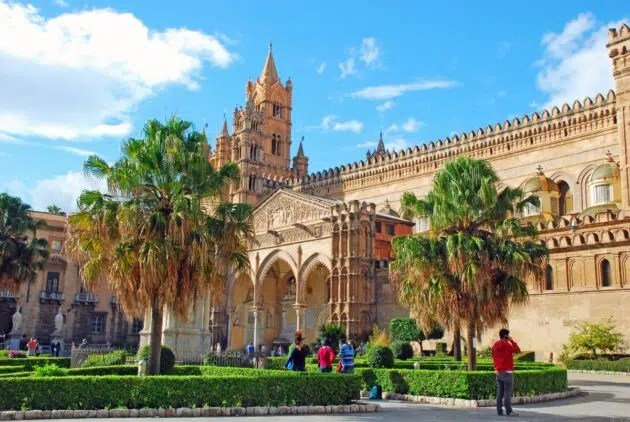- Your cart is empty
- Continue shopping

Visiting Palermo means encountering the city’s contradictions at every corner. Grand palaces stand alongside historic monuments, and sunny squares lead into a maze of narrow, shaded streets.
With a rich and complex history dating back to ancient times, Palermo was founded around the 8th century BC and has seen many occupiers, including Arab, Norman, Byzantine, French and Spanish rulers. Come and explore the countless historical sites of Palermo, a city with a unique character.
What to do in Palermo: Discover the capital of Sicily and one of the oldest cities in Europe
1. Norman Palace and Palatine Church
The Norman Palace is a symbol of Palermo’s unique cultural mix. Once a Punic and Roman fortress, it became the residence of Muslim princes and Norman kings, and today it serves as the region’s parliament. Its most notable landmark is the Palatine Chapel, a stunning space covered in medieval mosaics and gilded decorations.
2. Palermo Cathedral
The Cathedral of Santa Maria Assunta, dating from the 12th century, blends Romanesque architecture with Arab influences. Built on the site of an earlier mosque (and before that a Roman temple), the cathedral features ornate exterior facades that contrast with the more austere Baroque interior.
3. Teatro Massimo Vittorio Emanuele: The largest theater in Italy
Teatro Massimo, the largest opera house in Italy and the third largest in Europe, can accommodate more than 1,600 guests and accommodate 700 performers on stage. Restored and reopened in 1997, it is an impressive landmark well worth a visit.
4. Palermo Palaces
Palermo’s streets are lined with grand palaces, which are often accessible to the public. Along Via Maceda, you can find the Palazzo Gracellini, Kometini and Mazzarino, while movie lovers can visit the famous Palazzo Gangi with its halls in Cheetah. Also don’t miss the 12th-century Zisa Pleasure Palace, which showcases Arab architecture commissioned by the Norman King William I.
5. The most beautiful squares of Palermo
Palermo’s squares offer a glimpse into the city’s history and culture. Quattro Canti, a Baroque crossroads, marks the center of the city. Nearby, Bellini Square features the stunning Martorana Church, while Pretoria Square features a large 16th-century fountain.
6. Capuchin catacombs
One of the most unusual and popular sites in Palermo, the Capuchin Catacombs house 8,000 mummified bodies in an underground chamber, preserved in clothing as evidence of a unique cultural practice.
7. Street food and markets in Palermo
Experience the flavors of Sicily at Palermo’s markets, such as Ballaro and Fucceria. Sample local dishes such as Pane con la Milza, pasta with sea urchins, and Panele, which is fried chickpeas paired with fresh orange juice spremuta d’arancia.
8. Boat trip
A boat trip is a great way to enjoy the beauty of Sicily’s coast, with one- or two-day cruises offering stops in places like the Aeolian Islands and the stunning views of Vulcano.
9. More sights in Palermo
- Fucheria Market
- Al-Burgiriya area
- Antonio Salinas Regional Archaeological Museum
- Palermo Botanical Garden




10. Things to do around Palermo
Sicily offers many wonderful sites just outside of Palermo, including Monreale Cathedral, Mondello Beach and the town of Cefalù. Venture further to explore the Valley of the Temples in Agrigento, which can be reached by a two-hour train ride.
